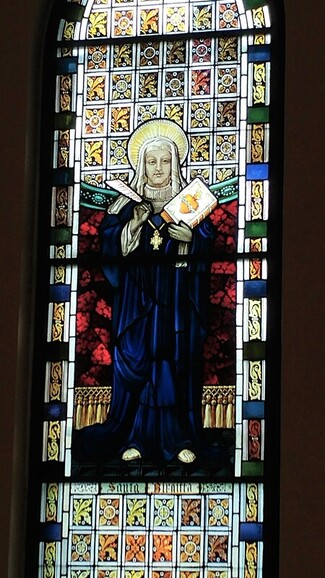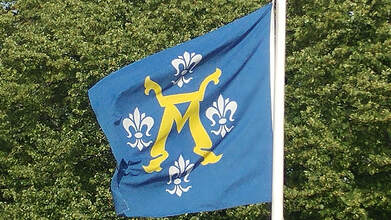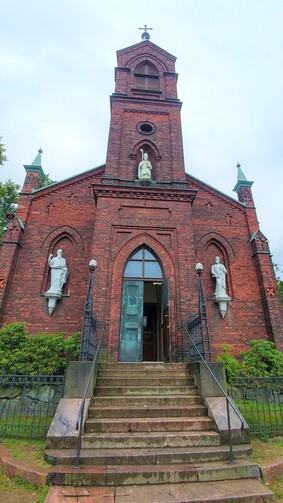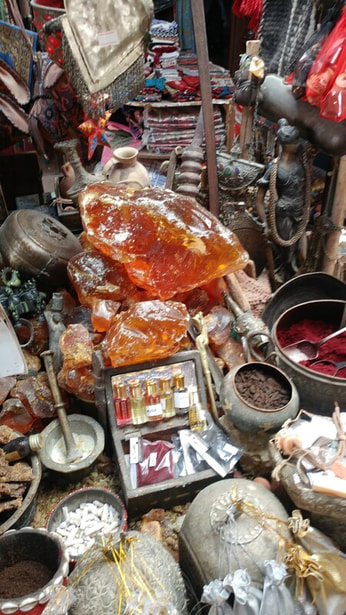 Naantali, July 17, 2019 The religious expression of Catholicism means that a person is called to flourish in their vocation, whether it’s married life, religious life, or the priesthood. And in each of these vocations, the person is called to live their full spiritual potential -- the perfection for which God has created them: holiness. Monastic life has flourished as centres of learning and sanctification. One such Order was founded by the Bridget of Sweden who founded the Order of the Most Holy Saviour also known as the Bridgettines in 1344. The Bridgettines received their approval by Pope Urban V in 1370. The Order flourished of monks and nuns attached to the same Abbess sharing monastic grounds separated by their cloisters. The Abbess elected by the nuns and monks governed the monastery. These abbesses were well-educated women and had the gift of courage to lead and govern. Bridgettine spirituality was embraced by the local people and penetrated their lives placing Christ at the center following the visions of Bridget. Monasteries opened across the Nordic countries and in her own lifetime Bridget was known for her communion with God; pilgrims visited her for prayers, intercession, guidance. The Lutheran reformers, instead, viewed these independent monasteries as incompatible with the narrow reformist doctrines, but also as an opportunity to acquire significant monastic assets. Instructed by Genesis (1:28), and Luther’s De Votis Monasticis “On Monastic Vows,” the Lutheran reformers argued the woman’s God-given duty was to marry and bear children, supporting Luther’s position on the uselessness of religious life. With Lutheran teaching dominating the Swedish reformers who imposed themselves on devout Roman Catholics, Swedish or Finn, the Reformers were determined to bring an end to monastic life.
0 Comments
 Turku, July 18, 2019 Given the late Swedish creation of Helsinki (1550), the presence of the Catholic Church in Helsinki certainly does not have the history that the Catholic faith expressed in Finland’s city of Turku. The beautiful city of Turku with the Aura river flowing through reveals signs of its medieval and Roman Catholic past – and present. Turku, its Finnish name is also known by its Swedish name, Åbo. Looking at the flag of Turku immediately present is the AM – Ave Maria -- on a blue background with the lily on four sides. The flag dates back to 1309 reflecting the earlier consecration of the cathedral to the Blessed Virgin Mary in 1300. The Cathedral of Medieval Turku was placed under the patronage of the Virgin and St. Henry, patron of Finland. These two elements, flag and Cathedral are indicative of a Roman Catholic town already settled and flourishing in the Middle Ages. The Dominican Order having arrived in Finlandia in 1249 established themselves in their new convent of St. Olaf in Turku close to the newly consecrated Cathedral. Turku was elevated to the status of Archdiocese and recognised as the most important Church in Finland. Blessed Bishop Hemming’s relics were located in the altar of the Roman Catholic Cathedral. Bishop Hemming of Turku knew Pope Clement VI and was also friends with St. Bridget of Sweden. The town’s Marian flag, the cathedral under the patronage of the Blessed Virgin and St. Henry, the Archbishop’s cathedral chair, demonstrate Turku’s solid link with the Church of Rome.  Helsinski, July 15, 2019 My visit to Finland was motivated by a Finnish friend of mine who had boldly left his Lutheran past to become a Roman Catholic. But not only did Tuomas embrace Catholicism, he was recently ordained as a Roman Catholic Priest. And so my visit to Finland, was to receive the priestly blessing of this courageous friend. Helsinki, or Swedish, Helsingfors, was created during Swedish control of Finland and later taken over by Russia until the Finns succeeded in claiming their independence from Russia during the period of the Communist revolution of 1917. Visiting Fr. Tuomas, I also discovered Catholic Finland. My arrival in Helsinki could not ignore two magnificent Churches, the Russian Orthodox which reflected the prominence of Russia and its russification policies and its Orthodox presence; then, the opulent Lutheran Church shaping the Helsinki skyline with twelve statues of Apostles financed through Finland’s taxation system privileging the Lutheran Church.  Could Petra have been a stopping point of the wise men following the star that would lead them to Bethlehem? It’s certainly probable. If we consider the geographic position, and commercial centre of Petra around the beginning of the Christian era, we have good reason to believe the Wise Men at least sojourned in Petra – perhaps even bought their gifts there. With the Nabateans, nomadic Arabs who monopolised the merchant trade route, Petra flourished in the 1st century BC, especially in the spice trade. The Nabatean inhabitants were especially skillful in collecting rainwater a precious commodity in the desert not only for human consumption but also to provide camels with plenty of drinking water for their long journeys across the dessert. It was in 106 AD that the Nabateans were defeated by the Romans and became part of the Roman Province of Arabia. So when did the Wise Men appear? Petra connects African and Arabian trade routes and even the northern route extending to Syria. Petra connects the Arabian trade route to the east as the Wise Men coming from the east followed the star west. The Wise Men are all from the east, Balthasar from Arabia with frankincense, Melchior from Persia with Myrrh, and Gaspar from India with Gold. They may have brought these gifts from the homeland, or with all the commerce in Petra, they may have obtained their gifts right in Petra. So, on this eastern axis they moved west. It makes sense to refuel in Petra whether an abundance of water filled the camels with liters of energy. A sophisticated town with inns for travellers, food, and that most important desert commodity: water. Then, of course, in the center of commerce, the Wise Men had the opportunity to explore and compare, Frankincense, Myrrh and Gold, as they returned to the path of their bright star leading the way north. |
AuthorFr. David Bellusci, O.P. List by Titles
Archives
May 2023
Categories
All
|
 RSS Feed
RSS Feed